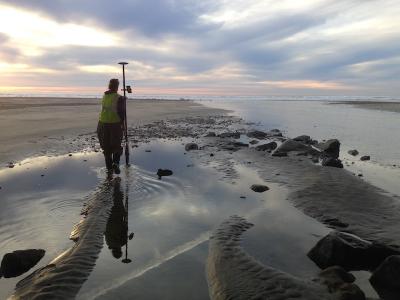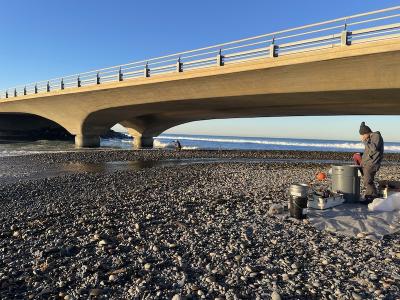The San Diego Estuaries Research Symposium, held on Feb. 7, helped connect the dots between science and management in the region.
San Diego is home to numerous coastal wetlands, including the largest and most intact in Southern California, the Tijuana Estuary. As part of the National Estuarine Research Reserve System, the Tijuana Estuary serves as a living laboratory where researchers conduct innovative wetland science that is significant for all of Southern California.
“Estuaries serve many functions,” said Kristen Goodrich, the coastal training program coordinator at the Tijuana River National Estuarine Research Reserve (TRNERR).

“They’re vital habitats. They’re recreational areas for the public,” she said. “So our basic idea was to connect researchers focused on the estuary ecosystems with the people who manage estuary resources."
The online symposium shared new research results from the Tijuana Estuary and other local systems with wetland managers and local community groups. Sponsored by TRNERR, Scripps Institution of Oceanography (SIO) and California Sea Grant, with support from National Centers for Coastal Ocean Science, California State Parks and the National Estuarine Research Reserve System Science Collaborative, the symposium expanded on a smaller 2019 event that was held in the TRNERR training center. This year’s symposium was broadcast virtually, thereby reaching a much wider audience. More than 100 attendees tuned in throughout the day from across California. A recording of the event is available on YouTube.
To help local managers focus on the science most relevant to their work, the symposium was organized into three overarching topics. The initial presentations examined the dynamic connection between the estuary inlets and the region’s beaches and the ocean. These presentations emphasized how sand and cobble from the beaches can influence the estuary opening and its ability to support tidal exchange. Another set of presentations provided updates on ongoing salt marsh and dune habitat changes after restoration efforts. The longest block, with four presentations, focused on ecosystem health, including innovative methods for tracking contaminants and hypoxic events and how various estuary species were responding to these stressors.
The presenters often sought insights from participants.
Luke Miller, a biologist at San Diego State University, asked audience members how his project using oysters as “biosensors” might be applied in other wetland areas.
Sarah Giddings, a physical oceanographer at SIO, researches how ocean waves can clog or close estuary mouths and carry run-off contaminants to nearby beaches. Giddings encouraged participants to identify what kinds of predictive or real-time modeling could help with notifications about public safety or swimming hazards.

Many of the symposium presentations highlighted the challenges associated with the San Diego estuaries being located in densely populated coastal areas.
“I really appreciated that so many of the talks covered the human component,” said Laura Engeman, a coastal climate resilience specialist at California Sea Grant and the Center for Climate Change Impacts and Adaptation at SIO.
“Today’s estuaries are dependent on human intervention for addressing historic contaminants and habitat loss,” she said. “However, we also have to keep evaluating and experimenting to understand when coastal management like beach nourishment or dredging may be benefiting one system but hurting another.”
Audience members and researchers expressed the need for continued monitoring and dialogue about the estuary health and its responses to experimental management and restoration strategies.
In response, Jeff Crooks, TRNERR’s research director, suggested that “there’s an opportunity for the symposium to grow larger still, to cover more estuaries and provide ever-clearer scientific information to resource managers, and to the public, helping improve restoration efforts along this coast.”
For more details, see the Symposium Summary.
About California Sea Grant
NOAA’s California Sea Grant College Program funds marine research, education and outreach throughout California. Headquartered at Scripps Institution of Oceanography at the University of California San Diego, California Sea Grant is one of 34 Sea Grant programs in the National Oceanic and Atmospheric Administration (NOAA), U.S. Department of Commerce.
About Scripps Oceanography
Scripps Institution of Oceanography at the University of California San Diego is one of the world’s most important centers for global earth science research and education. In its second century of discovery, Scripps scientists work to understand and protect the planet, and investigate our oceans, Earth, and atmosphere to find solutions to our greatest environmental challenges. Scripps offers unparalleled education and training for the next generation of scientific and environmental leaders through its undergraduate, master’s and doctoral programs. The institution also operates a fleet of four oceanographic research vessels, and is home to Birch Aquarium at Scripps, the public exploration center that welcomes 500,000 visitors each year.